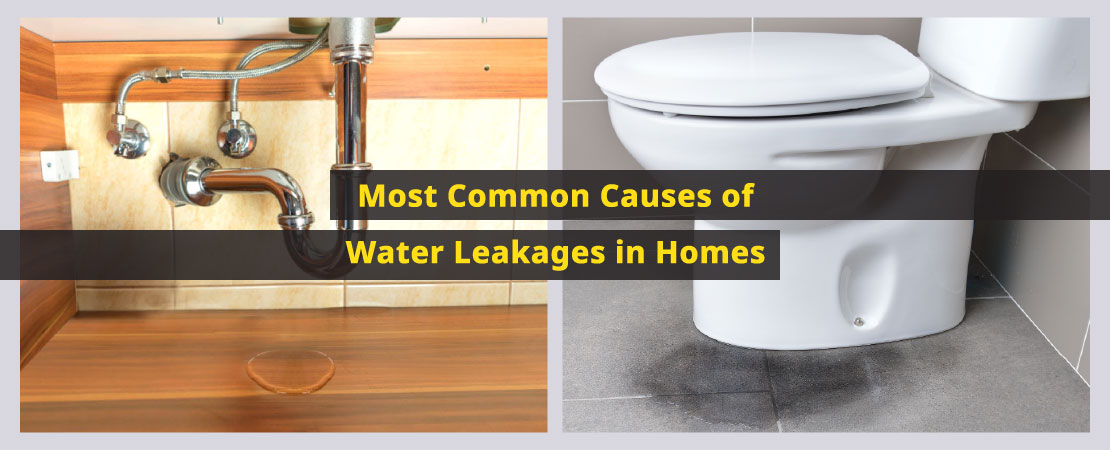Water leakage is a serious issue inside a house which should be dealt with in urgency. There are quite a number of factors and reasons contributing to water leakage – it may be leaking plumbing lines or corrosion in plumbing lines, cracks in the walls, damaged waterproofing in the roof, or a leaking AC. Water leakage inside the house leads to serious issues like stale-smelling indoors, growth of microbes, pests inside the house, damaged property and a lot more. So, while you need a thorough health check-up of the house, here’s a heads up about the possible causes and their effects.
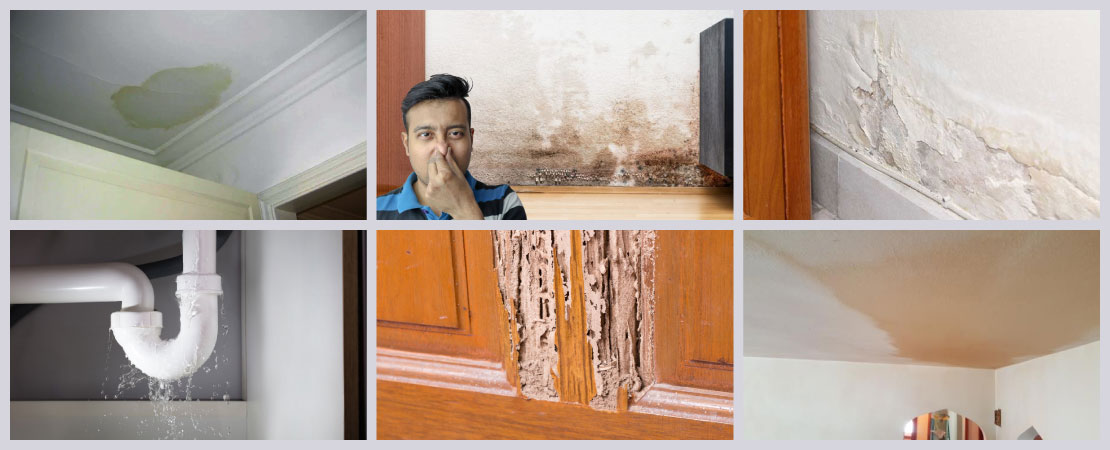
Water Leakage: Signs and Signals
Leakage can waste water, damage your home, and encourage unwanted organic growth. As you cannot see most of the pipework in your home, you may not always know that a leak has formed.
One of the best ways to protect your home from future leaks is to understand and look for common situations that cause leaks. Watch out for these common signals of water leakage:
- Dark patches on the walls and ceiling
- A stale and musty odour
- Peeling off of paint and plaster crumble
- Visual leaks
- The occurrence of pests, especially termites
- Watermarks and discolouration
A dampened environment in your house can lead to serious problems which are also signals of water leakage / seepage in your house. Skin rashes and allergy, asthma, nasal and throat congestion, coughing and wheezing can be caused by dampness due to water leakage or the bacteria which grows inside the household as a result of dampening.
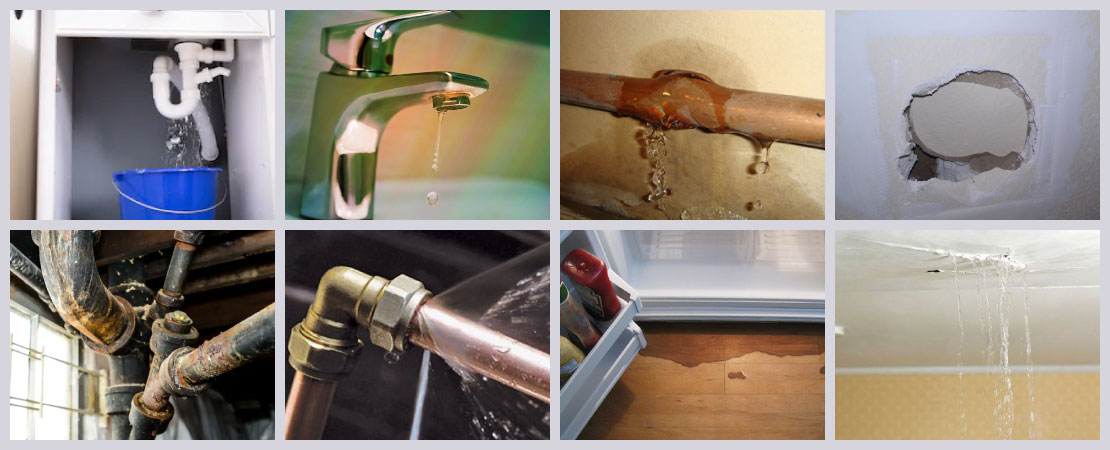
Common Causes of Water Leakage inside the House
- Leakage from underneath the water sink can be a serious problem. This can happen due to loose or improper connection at the bottle trap or waste coupler tread joint.
- Dripping faucets can be a serious and common problem of water leakage. Over tightening of a tap can cause it to leak. When a tap is hardened too much, it starts to develop a leak due to the wearing and tearing of the tap washer. A loose operating head or lever can lead to a similar problem. Sometimes debris get stuck inside the tap which may cause it to leak. Another common case is when people do not turn them off well enough.
- Leaking pipes are a major contributor to water leakage in households. They are often embedded inside walls and are difficult to detect. You only get to know when the wall surfaces start to deteriorate. It is a clear sign of dampness which is difficult to get rid of.
- If there are any leakage or moisture-related issues in the wall for some reason, vegetation will grow on the walls. This vegetation develops further cracks in the wall causing further deterioration.
- In case of negligence, if cavities and holes are left in the wall, they behave as a source of attracting and storing moisture. They cause water seepage and an unhealthy condition in the household.
- If your plumbing system is extremely old, rust and other forms of corrosion may wear it away. There will be discolouration on your pipes. This will cause water leakage inside the household. Rust can have other damaging effects too. Accumulation of rust may block the flow of water in the pipes resulting in the raising of water pressure and leakage. Severe rusting may also weaken the pipes and erode through the pipes causing leaks. To understand where leakage can happen, you need to understand the plumbing system of your home.
- Damaged pipe joints are another common reason for water leakage in a building. Do you know why? – Because, the place where pipes connect often represents the weakest point in a line. It is always under significant pressure. Similarly, we have to avoid usage of extension piece for FTA(Female thread adapter – which is used to connect plumbing line to tap) during improper installation of plumbing fitting. Over time, these pipe joints deteriorate causing leakage.
- Extreme temperature changes inside the pipelines can cause it to expand and contract alternately, which may cause cracks to develop inside the pipeline. This will cause leakage inside the pipelines. However, this is common mostly in hilly areas like Shimla, Dalhousie, Gangtok, etc.
- Refrigerators1 or water purifiers2 can also cause water leakage inside your household. If these go unnoticed for a long period of time, they can cause serious damage to your floor. It is also extremely unsafe to use the appliances while they are leaking as they may result in an electric shock.
- Leaky roofs, mainly caused due to deteriorated waterproofing, can contribute to water seepage inside the house. The improper slope can cause rainwater to accumulate on the rooftop / terrace which may then seep into the house.You must also make sure that there are no open electrical conduits on the rooftop or else, leaking water may enter the wiring system and cause serious problems downward (in case of the connection running downward).
- All types of pipes and faucets are manufactured to withstand up to a certain level of water pressure. Any extra pressure or uneven surge can put a strain on them causing them to give away after a certain point in time. The result is leakage.
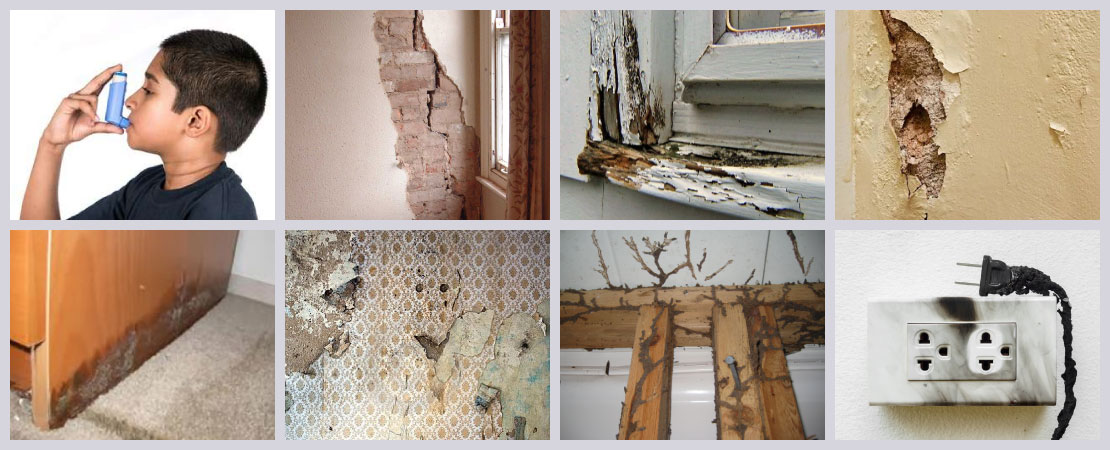
Effects of Water Leakage in House
- Unhygienic conditions: Water and moisture inside a house are accompanied by bacterial and fungal growth. This might lead to diseases like asthma, allergic rhinitis, skin rashes, depression and so on.
- Disintegration: Porous walls hold moisture for a longer time which may lead to deterioration of the walls & further damage. The bricks may develop cracks and fissures due to alternate cooling and expansion of water present in them.
- Decaying windows and doors: Moisture may lead to the decay of windows and doors. They swell and tend to touch the floor causing obstruction during opening & closing and other related damages. The decay of wood frames, ironwork, bricks, etc may also be caused by moisture.
- Plaster crumbles: On absorbing moisture, plaster turns soft and crumbles giving an ugly appearance to the walls.
- Damaged wooden furniture: Wooden furniture gets damaged on continuous exposure to a damp environment.
- Wall decorations are damaged: Wall decorations such as cladding, wallpapering, timber handicrafts are damaged as they absorb moisture from the damp walls. This ruins the aesthetics & weakens the structural integrity of your house completely which cannot be redone without solving the leakage problems from the core.
- Termite infestation: Dampness attracts gregarious pests in a home – be it cockroaches, ants or termites. In fact, termites prefer living in areas with high moisture content. They infest damp walls making them porous and damage wooden furniture and structures.
- Damage of electrical equipment: Electrical equipment may get damaged and short circuits may happen. It is extremely dangerous to use electrical installations in such situations. So, you must try to avoid dampness caused due to leakage / seepage, in the first place, especially where there are electrical outlets like appliances and switches and also see to it that water does not come in contact with the electrical wiring of the house.
Trust us, water leakage (and seepage) which is the main culprit behind dampness can be a real threat to your home. Fix it before it costs you your peace of mind.
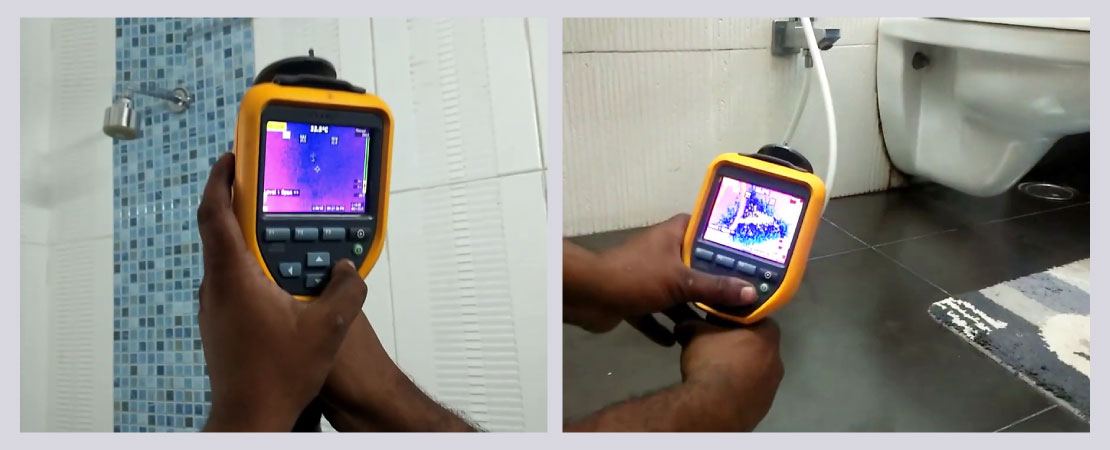
Moisture assessment using thermal imaging technology
Thanks to the advancement of technology, infrared cameras or thermal imagers are making moisture assessment in buildings easier than ever. These cameras can swiftly and, most importantly, non-invasively focus on the probable areas of anomalies caused by excessive evaporative moisture cooling. The images formed on the lens of these devices actually show patterns of moisture-spread that only trained eyes can decipher. Hence, only professionals associated with building investigation should be relied upon for such a technology-centric yet accurate investigation procedure. Here’s more on thermal imaging3 and why it is becoming essential for moisture detection.
Watch this to get a clearer idea of how leakage/seepage is detected in a home:
Your home is the place where you spend the maximum of your time. After a hectic day at work, we get back to our home and relax. We would definitely not like to stay in a stale smelling, unhygienic and dampened house where water is leaking. Our home is our abode which should brighten up our mood. A dampened environment would make us gloomy. Water leakage / seepage inside the house should be tracked down and be treated at the earliest possible time as it is not only unhygienic but also unsafe. It is always advisable to take the help of professionals – the home inspectors for this or else you may overlook some issues or end up doing a wrong assessment of the problem. By employing thermal imaging technology, any hidden leakage can be detected to the source before they become large problem and lead to serious damage which can make your home unhealthy.
Reference links used:
1. https://www.samsung.com/in/support/home-appliances/water-leakage-in-refrigerator/
2. https://www.eurekaforbes.com/blog/how-to-maintain-a-water-purifier-efficiently.html
3. https://www.fluke.com/en-in/learn/blog/thermal-imaging/why-thermal-imaging-is-essential-for-detecting-moisture-damage

